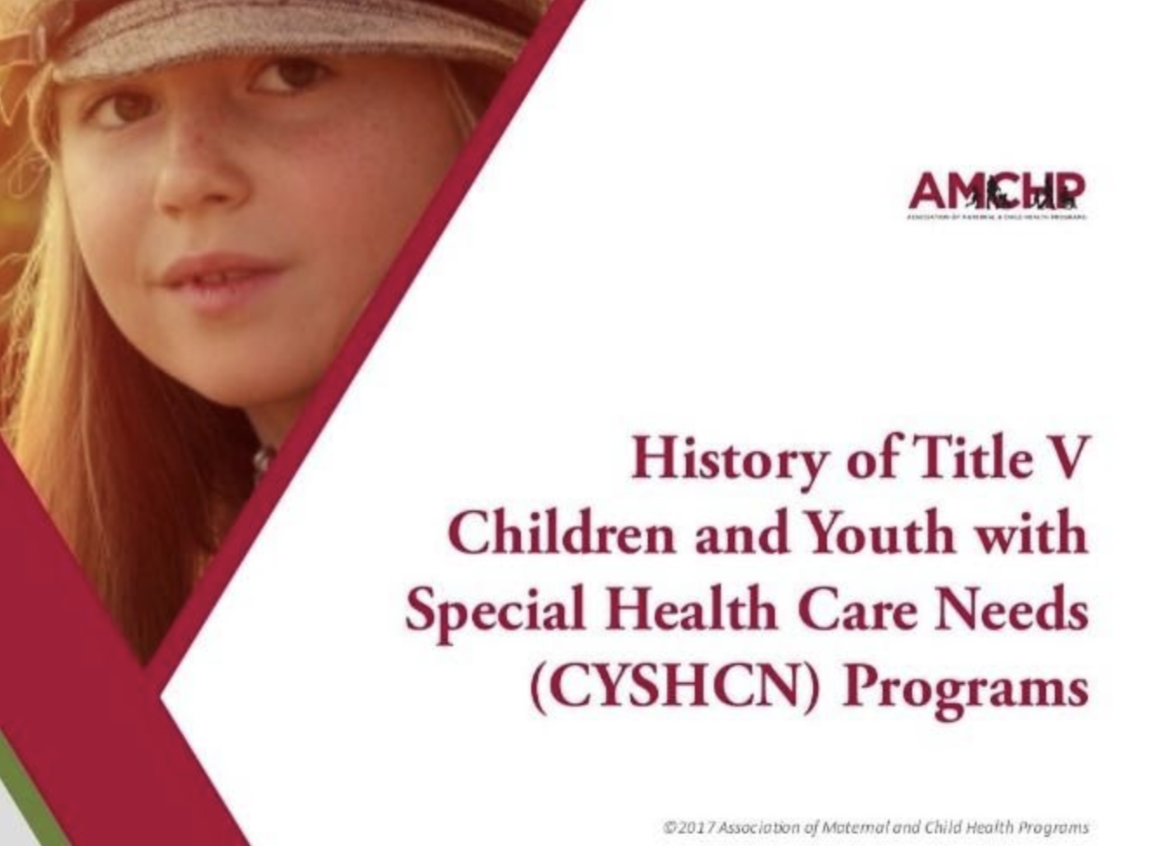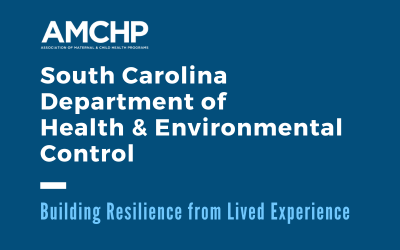In the United States, an estimated 13.8 million children, or approximately 19% of U.S. children under the age of 18, have special health care needs. Children and youth with special health care needs (CYSHCN) are a diverse group of children, ranging from children with chronic conditions to those who are more medically complex, to children with behavioral or emotional conditions. The Maternal and Child Health Bureau defines CYSHCN as children who “have or are at increased risk for a chronic physical, developmental, behavioral or emotional condition and who also require health and related services of a type or amount beyond that required by children generally”.
As a national advocate for maternal & child health, AMCHP partners with national and state agencies and organizations, such as state Title V CYSHCN Programs, to ensure these children receive high quality, family-centered, coordinated health services within an effective system of care. You can read about our CYSHCN program areas below, including how we support state Title V CYSHCN programs and how we advocate for all CYSHCN to receive care in a well-functioning system.
Our CYSHCN programs are supported by the United States Department of Health and Human Services’ Centers for Disease Control and Prevention (CDC) and the Health Resources Services Administration (HRSA) Maternal and Child Health Bureau (MCHB).
Current Initiatives
Program Areas
Title V Children & Youth with Special Health Care Needs (CYSHCN) Programs
 Title V of the 1935 Social Security Act provides funding for the Title V MCH Block Grant, which helps all 59 state and jurisdictions in implementing family-centered, community-based, systems of coordinated care for children with special health care needs. CYSHCN programs have evolved in their over-80-year history and there has been a recent shift to strengthen the systems that serve the CYSHCN population across CYSHCN programs to incorporate public health services, systems, and/or population health strategies to increase the reach, impact, and sustainability of the federal and jurisdiction funds that support Title V programs.
Title V of the 1935 Social Security Act provides funding for the Title V MCH Block Grant, which helps all 59 state and jurisdictions in implementing family-centered, community-based, systems of coordinated care for children with special health care needs. CYSHCN programs have evolved in their over-80-year history and there has been a recent shift to strengthen the systems that serve the CYSHCN population across CYSHCN programs to incorporate public health services, systems, and/or population health strategies to increase the reach, impact, and sustainability of the federal and jurisdiction funds that support Title V programs.
Check out AMCHP’s interactive, self-paced learning module with closed captioning focused on the History of Title V Children and Youth with Special Health Care Needs (CYSHCN) Programs! This tool was developed in response to a growing need to understand the challenging context that has led to the current structure and policies around Title V CYSHCN programs. The module includes research-based content, resources, and perspectives from key experts from the Maternal and Child Health field. This tool may also be used as a refresher for Title V staff and other health professionals to describe progress in state Title V CYSHCN activities and how these programs are moving forward.
Whether you are a Title V leader, health professional, student, or other key stakeholder, this module is a great tool for you! To access the module, click here or click on the picture above. If you experience any issues accessing the module, please email Paige Bussanich at pbussanich@amchp.org.
Title V National Performance Measures
AMCHP supports its members that work on fifteen national performance measures (NPMs) to improve the systems of care for MCH populations. The Title V MCH Block Grant uses these NPMs as part of a three-tiered framework that allows states and jurisdictions to identify priority measures to meet the needs of their state/jurisdiction. Title V programs will track prevalence rates of these NPMs over time to measure impact. There are several different NPMs that are related to CYSHCN and AMCHP has created implementation toolkits for each that provide specific evidence-based practices, reports, publications, and resources which can be adapted and implemented:
- NPM 6: Percent of children, ages 9 through 35 months, who received a Developmental Screening using a parent-completed screening tool in the past year
- AMCHP’s State Public Health Autism Resource Center (SPHARC) has developed a number of additional resources to support states in implementing this National Performance Measure around Developmental Screening.
- AMCHP’s State Public Health Autism Resource Center (SPHARC) has developed a number of additional resources to support states in implementing this National Performance Measure around Developmental Screening.
This resource highlights key strategies used by states to increase developmental screening and improve approaches to meeting the service and systems-level needs for children and their families.
Communicating the Value of Developmental Screening: A Learning Module. This informational module aims to build capacity of Title V leaders and other health professionals in articulating the value of developmental screening with various stakeholders.
- NPM 11: To increase the percent of children with and without special health care needs who have a Medical Home
- NPM 12: Percent of adolescents with and without special health care needs who received services necessary to make transitions to adult care
- NPM 15: Percentage of children, ages 0 through 17, who are continuously and adequately insured
To learn more about effective, replicable practices that positively impact CYSHCN, visit AMCHP’s Innovation Hub where you can search for practices by population focus, NPM, and several other search criteria.
Supporting Comprehensive, Coordinated Systems of Care
CYSHCN represent less than 20% of the total child population in the US yet are more impacted by health inequities than children without SHCN. Racial and ethnic disparities are seen in prevalence, access to care and resources, care coordination and satisfaction with care among CYSHCN and their families. Thus, it can be inferred that the needs of CYSHCN and their families continue to be underrepresented and undervalued within the broader scope of Title V MCH priorities and programs.
However, the grim reality— is that 86% of CYSHCN do not receive care in a well-functioning system. AMCHP feels that building stronger systems to support children with special health care needs and disabilities will not only improve their circumstances but will benefit the entire community. See below for key resources that are aligned with each of the six components of a well-functioning system of care:
- Families are partners in care.
- Issue Brief— Family Navigation implementation strategies in Title V and community-based programs
- See Family Engagement pages for resources and more information
- Children are screened early and continuously for special health care needs.
- Each year, approximately four million infants are screened in the U.S. for a variety of genetic and other congenital disorders. Identifying infants with congenital disorders early is vital to preventing their death and limiting illness. State MCH programs play a vital role in supporting newborn screening programs by coordinating the system components; ensuring stakeholder involvement; educating health care providers, families, and policymakers about the system; conducting surveillance and monitoring activities to ensure quality; and conducting follow-up care and connection to services. Learn more about AMCHP’s work in newborn screening here.
- See AMCHP’s Implementation Toolkit for National Performance Measure (NPM) 6: Percent of children, ages 9 through 35 months, who received a Developmental Screening using a parent-completed screening tool in the past year
- All CYSHCN receive care in a family-centered, accessible, continuous, comprehensive, coordinated, compassionate, and culturally effective medical home.
- See AMCHP’s Implementation Toolkit for National Performance Measure (NPM) 11: To increase the percent of children with and without special health care needs who have a Medical Home
- Community-based services are easily accessible by all families of CYSHCN.
- All CYSHCN are adequately insured.
- See AMCHP’s Implementation Toolkit for National Performance Measure (NPM) 15: Percentage of children, ages 0 through 17, who are continuously and adequately insured
- Adolescents with special health care needs receive the services necessary to transition to quality adult life.
- See AMCHP’s Implementation Toolkit for National Performance Measure (NPM) 12: Percent of adolescents with and without special health care needs who received services necessary to make transitions to adult care
AMCHP Celebrates Birth Defects Awareness Month: Building Stronger Referral Systems Through Collaboration
By Justin Huang, Senior Program Analyst, Clinical & Community Collaboration Contributor: Eden Desta, Senior Communications Analyst AMCHP commemorates National Birth Defects Awareness Month this January by celebrating the launch of our new Referral to...
AMCHP is Awarded $3.4M to Form National Coordinating Center on Transition
The Project, which started on September 1, 2024, aims to develop and advance national, state, and local/community frameworks that support a successful transition from child to adult serving systems for youth with autism and/or epilepsy who have complex health and...
Building Resilience from Lived Experience – South Carolina Department of Health & Environmental Control
A Nursing Triage Line Connects Residents to Care During Emergencies By South Carolina Department of Health & Environmental Control (Anna Bleasdale) In South Carolina, one of the most frequent challenges we face as a state is preparing for natural disasters,...







